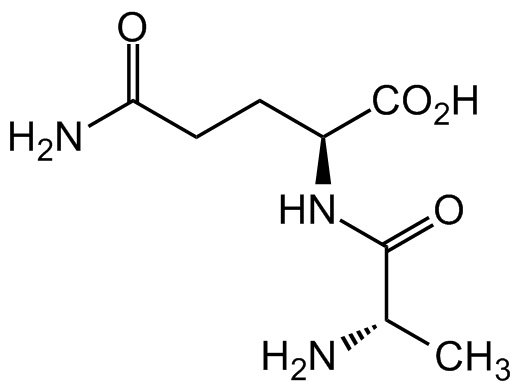L-Alanyl-L-glutamine
Product Code:
CDX-A0222
CDX-A0222
Regulatory Status:
RUO
RUO
Shipping:
AMBIENT
AMBIENT
Storage:
+20°C
+20°C
No additional charges, what you see is what you pay! *
| Code | Size | Price |
|---|
| CDX-A0222-G010 | 10 g | £59.00 |
Quantity:
| CDX-A0222-G050 | 50 g | £194.00 |
Quantity:
Prices exclude any Taxes / VAT
Stay in control of your spending. These prices have no additional charges, not even shipping!
* Rare exceptions are clearly labelled (only 0.14% of items!).
* Rare exceptions are clearly labelled (only 0.14% of items!).
Multibuy discounts available! Contact us to find what you can save.
This product comes from: Switzerland.
Typical lead time: 7-10 working days.
Contact us for more accurate information.
Typical lead time: 7-10 working days.
Contact us for more accurate information.
- Further Information
- Documents
- References
- Show All
Further Information
Alternate Names/Synonyms:
Ala-Gln; L-Ala L-Gln; Alanyl-glutamine; Glutamine-S
Appearance:
White to off-white powder.
CAS:
39537-23-0
EClass:
32160000
Form (Short):
liquid
Handling Advice:
Protect from light and moisture.
InChi:
InChI=1S/C8H15N3O4/c1-4(9)7(13)11-5(8(14)15)2-3-6(10)12/h4-5H,2-3,9H2,1H3,(H2,10,12)(H,11,13)(H,14,15)/t4-,5?/m0/s1
InChiKey:
HJCMDXDYPOUFDY-ROLXFIACSA-N
Long Description:
Chemical. CAS: 39537-23-0. Formula: C8H15N3O4. MW: 217.22. Synthetic. L-Glutamine is an essential supplement for cell culture. The free amino acid L-glutamine is unstable and degrades to pyroglutamate. Alanyl-L-glutamine (Ala-Gln) and Gylcyl-L-glutamine (Gly-Gln) are used in cell culture media as alternative delivery forms of stabilized L-glutamine. Alanyl-glutamine is a widely used alternative supplement to L-glutamine in the production of biopharmaceuticals, cosmetics and food products. Alanyl-glutamine also acts as an antioxidant (peroxide) and anti-apoptosis (LPS-induced) factor. Ala-Gln has been used in studies on injury and sepsis, and on the effects of irradiation on leucine and protein metabolism in vivo. Ala-Gln has been utilized to investigate polymorphonuclear leucocyte and myeloperoxidase activity in vitro. Shown to improve intestinal health and enhances the immune system. It is also involved in various clinical studies such as cancer treatment, radiation and chemotherapy. It improves pancreatic beta-cell function, maintaining the mitochondrial metabolism and stimulus-secretion coupling essential for insulin release.
MDL:
MFCD00133046
Molecular Formula:
C8H15N3O4
Molecular Weight:
217.22
Package Type:
Vial
Product Description:
L-Glutamine is an essential supplement for cell culture. The free amino acid L-glutamine is unstable and degrades to pyroglutamate. Alanyl-L-glutamine (Ala-Gln) and Gylcyl-L-glutamine (Gly-Gln) are used in cell culture media as alternative delivery forms of stabilized L-glutamine. Alanyl-glutamine is a widely used alternative supplement to L-glutamine in the production of biopharmaceuticals, cosmetics and food products. Alanyl-glutamine also acts as an antioxidant (peroxide) and anti-apoptosis (LPS-induced) factor. Ala-Gln has been used in studies on injury and sepsis, and on the effects of irradiation on leucine and protein metabolism in vivo. Ala-Gln has been utilized to investigate polymorphonuclear leucocyte and myeloperoxidase activity in vitro. Shown to improve intestinal health and enhances the immune system. It is also involved in various clinical studies such as cancer treatment, radiation and chemotherapy. It improves pancreatic beta-cell function, maintaining the mitochondrial metabolism and stimulus-secretion coupling essential for insulin release.
Purity:
>98% (HPLC)
SMILES:
NC(CC[C@H](NC([C@@H](N)C)=O)C(O)=O)=O
Solubility Chemicals:
Soluble in water (20 mg/ml), ethanol (20mg/ml), DMSO or DMF (30mg/ml).
Source / Host:
Synthetic.
Transportation:
Non-hazardous
UNSPSC Category:
Biochemical Reagents
UNSPSC Number:
12352200
Use & Stability:
Stable for at least 2 years after receipt when stored at RT.
Documents
References
(1) P.G. Boelens, et al.; Am. J. Physiol. Endocrinol. Metab. 291, E683 (2006) | (2) Y. Imamoto, et al.; Cytotechnology 65, 135 (2013) | (3) E.R. Petry, et al.; Life Sci. 94, 130 (2014) | (4) V.F. Cruzat, et al.; Nutrition 30, 602 (2014) | (5) M.V. Nova, et al.; Drug Dev. Ind. Pharm. 40, 1308 (2014) | (6) G. Wang, et al.; Ind. Eng. Chem. Res. 53, 3385 (2014) | (7) V.F. Cruzat, et al.; J. Endocrinol. 224, 261 (2015)



